Stone Mountain
Stone Mountain is a quartz monzonite dome monadnock and the site of Stone Mountain Park, 16 miles (26 km) east of Atlanta, Georgia. Outside the park is the small city of Stone Mountain, Georgia. The park is the most visited tourist site in the state of Georgia.
| Stone Mountain | |
|---|---|
 The mountain viewed from a distance | |
| Highest point | |
| Elevation | 1,686 ft (514 m) |
| Prominence | 825 ft (251 m) |
| Coordinates | 33°48′21.40″N 84°8′43.52″W |
| Geography | |
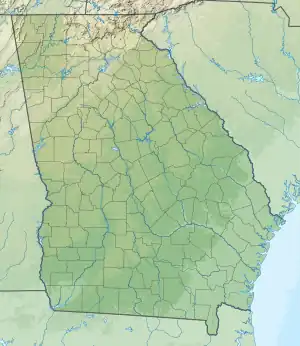 Stone Mountain | |
| Topo map | USGS Stone Mountain, Georgia |
The park is owned by the state of Georgia. At its summit, the elevation is 1,686 feet (514 m) above sea level and 825 feet (251 m) above the surrounding area. Stone Mountain is well known for not only its geology, but also the enormous rock relief on its north face, the largest bas-relief artwork in the world.[1] The carving, completed in 1972, depicts three Confederate leaders, Jefferson Davis, Robert E. Lee, and Stonewall Jackson.[2][3]
Stone Mountain, once owned by the Venable Brothers,[4] was seen from the outset "as a memorial to the Confederacy."[5] Stone Mountain Park officially opened on April 14, 1965 – 100 years to the day after Lincoln's assassination,[6] although the park had already been in use for a few years.[7]
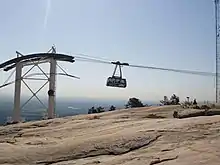
The mountain, which ranges in composition from quartz monzonite to granite and granodiorite, is more than 5 miles (8 km) in circumference at its base. The summit of the mountain can be reached by a walk-up trail on the west side of the mountain or by the Skyride aerial tram.
Geology

Stone Mountain is a pluton, a type of igneous intrusion. Primarily composed of quartz monzonite, the dome of Stone Mountain was formed during the formation of the Blue Ridge Mountains around 300–350 million years ago (during the Carboniferous period), part of the Appalachian Mountains.[8] It formed as a result of the upwelling of magma from within the Earth's crust. This magma solidified to form granite within the crust 5 to 10 miles (8 to 16 km) below the surface.
The Stone Mountain pluton continues underground 9 miles (14 km) at its longest point into Gwinnett County. Numerous reference books and Georgia literature have dubbed Stone Mountain as "the largest exposed piece of granite in the world".[9] This misconception is most likely a result of misrepresentation by granite companies and early park administration. Stone Mountain, though often called a pink granite dome, actually ranges in composition from quartz monzonite[10] to granite and granodiorite.[11]
The minerals within the rock include quartz, plagioclase feldspar, microcline, and muscovite, with smaller amounts of biotite and tourmaline. The tourmaline is mostly black in color, and the majority of it exists as optically continuous skeletal[12] crystals, but much larger, euhedral pegmatitic tourmaline crystals can also be found in the mountain's numerous, cross-cutting felsic dikes. Embedded in the granite are xenoliths or pieces of foreign rocks entrained in the magma.
The granite intruded into the metamorphic rocks of the Piedmont region during the last stages of the Alleghenian Orogeny, which was the time when North America and North Africa collided. Over time, erosion eventually exposed the present mountain of more resistant igneous rock. This intrusion of granite also gave rise to Panola Mountain and Arabia Mountain, both in DeKalb County, smaller outcroppings farther south of Stone Mountain.
Natural history
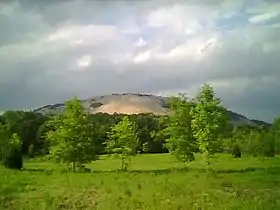
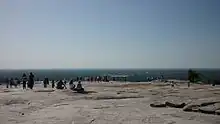
The top of the mountain is a landscape of bare rock and rock pools, and it provides views of the surrounding area including the skyline of downtown Atlanta, often Kennesaw Mountain, and on very clear days even the Appalachian Mountains. On some days, the top of the mountain is shrouded in a heavy fog, and visibility may be limited to only a few feet.
The clear freshwater pools on the summit form by rainwater gathering in eroded depressions, and are home to unusual clam shrimp and fairy shrimp. The tiny shrimp appear only during the rainy season. Through the process of cryptobiosis, the tiny shrimp eggs (or cysts) can remain dormant for years in the dried out depressions, awaiting favorable conditions. These vernal pools are also home to several federally listed rare and endangered plant species, such as black-spored quillwort (Isoetes melanospora) and pool sprite (also called snorkelwort, Gratiola amphiantha).[13][14]
The mountain's lower slopes are wooded. The rare Georgia oak was first discovered at the summit, and several specimens can easily be found along the walk-up trail and in the woods around the base of the mountain. In the fall, the Confederate yellow daisy (Helianthus porteri) flowers appear on the mountain, growing in rock crevices and in the large wooded areas. More than 120 wildflowers, most of them native to the Southern Appalachians and including several rare or federally protected species, have been identified on the mountain.[15]
 Leaves of the Georgia oak
Leaves of the Georgia oak Confederate yellow daisy (Helianthus porteri)
Confederate yellow daisy (Helianthus porteri) Pool sprite (Gratiola amphiantha)
Pool sprite (Gratiola amphiantha).jpg.webp) Quillwort (Isoetes melanospora)
Quillwort (Isoetes melanospora)
Confederate Memorial Carving

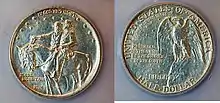
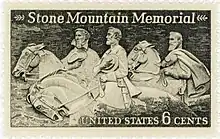

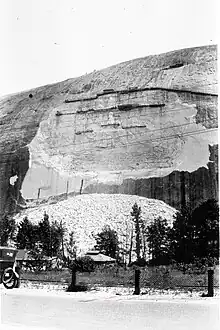
The largest bas-relief sculpture in the world, the Confederate Memorial Carving depicts three Confederate leaders of the Civil War: President Jefferson Davis and Generals Robert E. Lee and Thomas J. "Stonewall" Jackson (on their favorite horses, Blackjack, Traveller, and Little Sorrel, respectively). The sculpture was cut 42 feet (13 m) deep into the mountain,[16] measures 90 feet (27 m) in height and 190 feet (58 m) in width,[17] and lies 400 feet (120 m) above the ground.[18]
David Freeman, writing on the origins of the memorial, states: "Who first conceived of a Confederate memorial on the side of Stone Mountain has long been a matter of debate..... The written evidence...points to Francis Ticknor, a nineteenth-century physician and poet from Jones County, Georgia...in an 1869 poem.... William H. Terrell, an Atlanta attorney and son of a Confederate veteran, ...suggested it publicly on May 26, 1914 in an editorial for the Atlanta Constitution."[19]: 55 Three weeks later, Georgian John Temple Graves, editor of the New York American, suggested it should have a 70-foot (21 m) statue of Robert E. Lee.[19]: 56
The project was greatly advanced by C. Helen Plane,[20] a charter member of the United Daughters of the Confederacy (UDC) and first president and Honorary Life President of the Georgia State Division.[19]: 57 After obtaining the approval of the Georgia UDC, she set up the UDC Stone Mountain Memorial Association. She chose the sculptor Gutzon Borglum for the project and invited him to visit the mountain (although, despite his Ku Klux Klan involvement,[19]: 79 she "would not shake his hand—he was, after all, a Yankee").[19]: 58–59 She met him at the Atlanta train station, took him to her family's summer home, Mont Rest, at the foot of the mountain, and introduced him to Sam Venable,[19]: 59 an active Klan member and owner of the mountain. Borglum also enlisted Luigi Del Bianco, whom he would also involve in Mount Rushmore.[21]
Borglum's original plan was having five groups of figures, sixty-five mounted officers representing the states (to be chosen by the states), General Nathan Bedford Forrest and his cavalry—some 700 to 1,000 figures, each from 35 feet (11 m) to 50 feet (15 m) high. In addition, Borglum planned a room cut 60 feet (18 m) into the mountain, 320 feet (98 m) wide, and 40 feet (12 m) high, faced by 13 columns.[19]: 59–60
Venable deeded the north face of the mountain to the UDC in 1916, on the condition that it complete a sizable Civil War monument in 12 years. Finances as well as technical problems slowed progress. The U.S. Mint issued a 1925 Commemorative silver U.S. half dollar, bearing the words "Stone Mountain", as a fundraiser for the monument.[22] This issue, which required the approval of both the 1926 Congress and President Calvin Coolidge, was the largest issue of commemorative coins by the U.S. government up to that time.[19]: 81
Financial conflicts between Borglum and the Association led to his firing in 1925.[19]: 85 Borglum destroyed his models, claiming that they were his property, but the Association disagreed and had a warrant issued for his arrest. He was warned of the arrest and narrowly escaped to North Carolina, whose governor, Angus McLean, refused to extradite him,[19]: 89 though he could not return to Georgia. The affair was highly publicized and there was much discussion and discord, including discord between Sam Venable, the Association and Association president Hollins Randolph.[19]: 103, 116–119 The face of Lee that Borglum had partially completed was blasted off the mountain in 1928.[19]: 111
Borglum's next major project was Mount Rushmore.
After a number of sculptors turned them down,[19]: 97 Augustus Lukeman took up the work in 1925, with a different, smaller design. Fundraising was even more difficult after the public debate and name-calling, and work stopped in 1928. In 1941, segregationist Governor Eugene Talmadge formed the Stone Mountain Memorial Association (SMMA) to continue work on the memorial, but the project was delayed once again by the United States' entry into World War II (1941–45).[23]
In response to the 1954 Brown v. Board of Education Supreme Court ruling and the birth of the Civil Rights Movement, in 1958, at the urging of segregationist Governor Marvin Griffin,[6]: 21 the Georgia legislature approved a measure to purchase Stone Mountain at a price of $1,125,000. In 1963, Walker Hancock was selected to complete the carving, and work began in 1964. The carving was dedicated in a ceremony on May 9, 1970.[24] The carving was completed by Roy Faulkner on March 3, 1972.[25] Faulkner in 1985 opened the Stone Mountain Carving Museum (now closed) on nearby Memorial Drive commemorating the carving's history.[26] An extensive archival collection related to the project is now at Emory University, with the bulk of the materials dating from 1915 to 1930; the finding aid provides a history of the project, and an index of the papers contained in the collection.[20]
Four flags of the Confederacy are flown at the site.[27] The Stone Mountain Memorial Lawn "contains...thirteen terraces—one for each Confederate state.... Each terrace flies the flag that the state flew as member of the Confederacy."[28]
The replica plantation
In 1963, there opened beneath the sculpture a replica plantation, where slave quarters were described as "neat" and "well furnished" in promotional materials. The slaves were called "hands" or "workers," and black actress Butterfly McQueen (from Gone with the Wind) was hired to guide and inform visitors.[29] The park states that the plantation was inspired by Gone with the Wind.[30] The plantation has been renamed Historic Square.
Involvement of the Ku Klux Klan
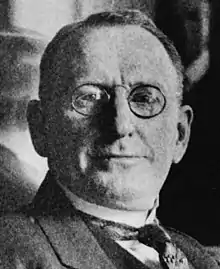
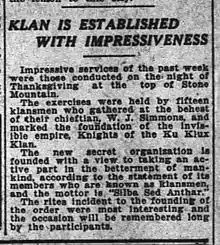
According to sociologist James W. Loewen, Stone Mountain was "the sacred site to members of the second and third national klans."[31]: 262 Loewen alleges that the rebirth of the Ku Klux Klan—the second Klan—was inspired by D. W. Griffith's 1915 Klan-glorifying film, The Birth of a Nation.[32] It was followed in August by the highly publicized lynching of Leo Frank, who had been convicted of murder, in nearby Marietta, Georgia. Loewen further alleges that on November 25 of the same year, Thanksgiving Day, a small group, including fifteen robed and hooded "charter members" of the new organization, met at the summit of Stone Mountain to create a new iteration of the Klan. Led by William J. Simmons, it included two elderly members of the original Klan. As part of their ceremony, they set up on the summit an altar covered with a flag, opened a Bible, and burned a 16 ft (4.9 m) cross.[6]: 20 [33]
James R. Venable attended the 1915 revival of the KKK on top of Stone Mountain and later became an Imperial Wizard of the National Knights of the Ku Klux Klan, which was one of the later KKK factions.[34] He owned land at the base of the mountain that he had inherited from his ancestors, and in October of 1923 he granted the Klan an easement with perpetual right to hold celebrations as they desired.[35] However, the property was condemned in 1960 at the behest of the Stone Mountain Memorial Association.[36]
The Klan also held cross-burnings at the summit of the mountain on different occasions from 1915 onward.[37][38] This practice came to an end in 1962, when the Klan attempted to hold a mountaintop cross-burning in response to the NAACP holding its national convention in Atlanta.[37] The Stone Mountain Memorial Association did not want either group using state property for demonstrations, and convinced Governor Ernest Vandiver to order state troopers to stop the event.[37] Seventy troopers attempted to stop several hundred Klansmen gathered at the base of the mountain from climbing to the summit, but the Klansmen were armed with billy clubs, flashlights, and stones, and greatly outnumbered the officers.[37] The police negotiated a truce with the local Klan Grand Dragon, under which the Klansmen would refrain from further violence, but 20 of their number would be allowed to climb the mountain for a “religious ceremony”, and the cross-burning was substituted with the lighting of a flare.[37]
In August of 2017, the Klan was denied a permit for a mountaintop cross-burning.[37]
Fundraising for the monument resumed in 1923. The influence of the UDC continued, in support of Mrs. Plane's vision of a carving explicitly for the purpose of creating a Confederate memorial. She suggested in a letter to the first sculptor, Gutzon Borglum:
I feel it is due to the Klan[,] which saved us from Negro dominations [sic] and carpetbag rule, that it be immortalized on Stone Mountain. Why not represent a small group of them in their nightly uniform approaching in the distance?[6]: 21 [23]
The UDC established the Stone Mountain Confederate Memorial Association (SMCMA) for fundraising and on-site supervision of the project. Venable and Borglum, both closely associated with the Klan, arranged to pack the SMCMA with Klan members.[39] The SMCMA, along with the United Daughters of the Confederacy, continued fundraising efforts. Of the $250,000 (~$3.11 million in 2021) raised, part came from the federal government, which in 1925 issued commemorative fifty-cent coins with the soldiers Robert E. Lee and Stonewall Jackson on them.[40] The image on the verso of the coin was based on The Last Meeting of Lee and Jackson,[41] executed in 1869 by Everett B. D. Fabrino Julio,[lower-alpha 1] itself an icon of Lost Cause mythology; it is now in the American Civil War Museum (until 2012 the Museum of the Confederacy).[42] When the state completed the purchase in 1960, it condemned the property to void Venable's agreement to allow the Klan perpetual right to hold meetings on the premises.[39]
Proposed removal of the carving
After the Charleston church shooting in mid-2015, Stone Mountain was the subject of a political debate related to the removal of symbols of the Confederacy.[43] This controversy was stimulated by a movement in other states to remove the Confederate battle flag and statues of Confederate leaders from public areas.
[The Confederate sculpture at Stone Mountain is] the largest shrine to white supremacy in the history of the world ... I don't think people understand the objective and the intent. They don't understand that it's based on white supremacy because the [American Civil War] was based on white supremacy, and the 'heroes' are based on white supremacy. After the killings at Emanuel Church in Charleston, it finally crystallized for me that these monuments encourage violence and validate oppression.
In July 2015, the Atlanta NAACP proposed removing the Confederate carving from Stone Mountain Park.[44] However, this would require the approval of the Georgia Legislature, as would any change to a "military monument" in the state.[45]
On October 11, 2015, The Atlanta Journal-Constitution reported the park was considering a proposal of a permanent "Freedom Bell" honoring Martin Luther King Jr. and the line "Let freedom ring from Stone Mountain of Georgia", from King's 1963 "I Have a Dream" speech.[46] The proposed monument is inspired by a bell-ringing ceremony held in 2013 honoring the 50th anniversary of King's speech. It is not supported by the NAACP or King-founded Southern Christian Leadership Conference (SCLC), who want the Confederate symbols removed rather than a King symbol added.[47] Advance Local reported in 2015 that both the DeKalb County branch of the NAACP and the Sons of Confederate Veterans were opposed to the bell because it would have been put next to a Confederate monument. Representatives of the NAACP were quoted in the article saying "It's an attempt to gain support from blacks to keep these racist and demeaning symbols."[48]
In August 2017, after the Unite the Right rally in Charlottesville, Virginia—a white nationalist protest against the removal of the Robert E. Lee monument and Stonewall Jackson sculpture—turned violent, many people across the country again demanded the removal of Confederate monuments and memorials as part of a national political debate.[49][50][51] Georgia State Representative and Democratic gubernatorial candidate Stacey Abrams called for the removal, by sandblasting, of Stone Mountain's carving.[52][53] She called it "a blight upon our state".[54][55]
On July 5, 2020, 100 to 200 armed protesters came to Stone Mountain to call for the carving's removal.[56] Known as the Not F------ Around Coalition (NFAC), it was a protest against both overt and systemic racism, calling out white supremacists, with the location being chosen in part due to its history as the place where the Ku Klux Klan was re-formed.[57]
On August 15, 2020, the park administration temporarily closed its gates in reaction to a gathering of white nationalists planned there, and the city's public buses were suspended for the day. Nevertheless, a fight broke out downtown between the gatherers downtown and counter-protesters, with no injuries reported.[58]
History
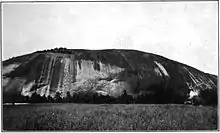
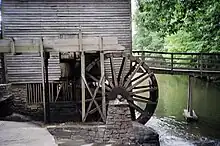
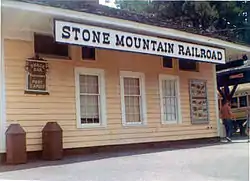
Human habitation of Stone Mountain and its surroundings date back into prehistory. When the mountain was first encountered by European explorers, its summit was encircled by a rock wall, similar to that still to be found on Georgia's Fort Mountain. The wall is believed to have been built by early Native American inhabitants of the area, although its purpose remains unclear. By the beginning of the 20th century, the wall had disappeared, the rocks having been taken away by early visitors as souvenirs, rolled down the rockface, or removed by the commercial quarrying operation. The mountain was the eastern end of the Campbellton Trail, a Native American path that ran through what is now the Atlanta area.
Europeans first learned of the mountain in 1567, when Spanish explorers were told of a mountain farther inland which was "very high, shining when the sun set like a fire." By this time, the Stone Mountain area was inhabited by the Creek and (to a lesser extent) Cherokee peoples.
In the early 19th century, the area was known as Rock Mountain. After the founding of DeKalb County and the county seat of Decatur in 1822, Stone Mountain was a natural recreation area; it was common for young couples on dates to ride to the mountain on horseback. The mountain is easy to climb and there has been a path since the nineteenth century.
Entrepreneur Aaron Cloud built a 165 foot (50 m) wooden observation tower at the summit of the mountain in 1838, but it was destroyed by a storm and replaced by a much smaller tower in 1851. Visitors to the mountain would travel to the area by rail and road, and then walk up the 1.1-mile (1.8 km) mountaintop trail to the top, where Cloud also had a restaurant and club.
Granite quarrying started at Stone Mountain in the 1830s, but became a major industry following the completion of a railroad spur to the quarry site in 1847. This line was rebuilt by the Georgia Railroad in 1869. Over the years, Stone Mountain granite was used in many buildings and structures, including the locks of the Panama Canal, the steps to the East Wing of the United States Capitol and the Imperial Hotel in Tokyo. In recent years, granite suppliers in Georgia sent stone samples cut from Stone Mountain to the group responsible for planning the Martin Luther King Jr. Memorial in Washington, D.C.; the foundation later chose to use granite imported from China.[59] Quarrying during earlier periods also destroyed several spectacular geological features on Stone Mountain, such as the Devil's Crossroads, which was located on top of the mountain.
In 1887, Stone Mountain was purchased for $45,000 by the Venable Brothers of Atlanta, who quarried the mountain for 24 more years, and descendants of the Venable family would retain ownership of the mountain until it was purchased by the State of Georgia in 1958.
Martin Luther King Jr. mentioned the monument in his "I Have a Dream" speech at the August 1963 March on Washington for Jobs and Freedom, when he said "let freedom ring from Stone Mountain of Georgia!"[60]
During the 1996 Summer Olympics, Stone Mountain Park provided venues for Olympic events in tennis, archery and track cycling.[61][62] The venues for archery and cycling were temporary and are now part of the songbird and habitat trail.[63]
Some of the outdoor scenes for the Netflix series Stranger Things were filmed in the park.[64]
Aviation incidents
According to George Weiblen's annotated calendar for Monday, May 7, 1928: "Mail plane crashed on mountain at 8:00 P.M." The pilot, Johnny S. Kytle (1905–1931), not only survived the crash, but managed to grab the mail and walk down the mountain.
Around dusk on September 16, 2003, in clear weather, a small airplane circled the mountain five times, crashed headlong into the south side, and burst into flames. The pilot was killed. A witness testifying at the NTSB investigation stated that the pilot, a 69-year-old accountant, had threatened on multiple occasions to commit suicide by flying into the mountain. The official NTSB accident report lists the probable cause as "The pilot's intentional flight into the ground for the purpose of suicide while impaired by alcohol."[65]
Governance
Stone Mountain Park, which surrounds the Confederate Memorial, is owned by the state of Georgia and managed by the Stone Mountain Memorial Association, a Georgia state authority. As of August, 2022, the board entered a 10-year contract (with the option to renew for up to 30 years) with Thrive Attractions Management Group, LLC, to operate park attractions. The Stone Mountain Memorial Association retains ownership, while Thrive keeps 2% of the annual gross revenues from the park's hotels and 3% of gross revenues from other areas.[66]
From 1999 to 2022, park attractions were managed by Herschend Family Entertainment Corporation, which had a 30-year contract to operate attractions. Under terms of a 1999 agreement, Herschend paid the state of Georgia $11 million (~$17.1 million in 2021) annually, while the Stone Mountain Memorial Association had the right to reject any project deemed unfit. In 2018, Herschend Family Entertainment Corporation decided to end their contract early after only 20 years due to record losses in 2017 and 2018, citing decreased revenues and “protests and division” fueled by the park’s ubiquitous Confederate imagery as factors. Bids for a new management company for Stone Mountain Park were submitted in October 2021.[67] Thrive Attractions Management Group, LLC, started by the previous Vice President of Herschend Family Entertainment Corporation and general manager of Stone Mountain Park for 10 years, Michael Dombrowski, submitted the only bid to the Mountain Memorial Association, which was approved on May 23, 2022.[66]
Places of interest
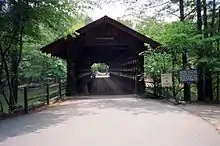
Confederate Hall, operated directly by the Stone Mountain Memorial Association (SMMA), is a museum that educates students and park guests on the geology and ecology of Stone Mountain as well as historical aspects of the area. A small theater shows a historical documentary about the Civil War in Georgia called The Battle for Georgia.
The education department is host to thousands of students each school year, teaching the subjects of geology, ecology, and history. Classes are designed to meet the Georgia Performance Standards and the North American Association for Environmental Education guidelines.
The Antebellum Plantation and Farmyard is an open-air museum composed of 19 historic buildings, built between 1790 and 1875, that have been re-erected on the site to represent a pre-Civil War Georgia plantation. The historic houses have been furnished with an extensive collection of period furniture and decorations. The farm features a petting zoo.
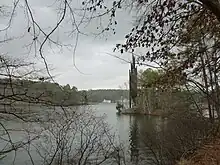
A grist mill dates from 1869 and was moved to the park in 1965. A covered bridge dates from 1892 and originally spanned the Oconee River in Athens, Georgia.[68]
The park provides daily concerts on a large carillon that originated at the 1964 New York World's Fair. The instrument consists of 732 bell-tone rods, electronically amplified through 60 speakers in a decorative 13-story structure.[69]
Broadcast tower
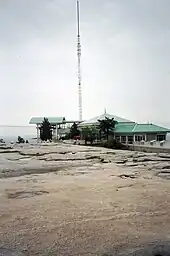
The short broadcast tower on the top of the mountain transmits two non-commercial stations: television station WGTV TV 8, and weather radio station KEC80 on 162.55 MHz. FM radio station WABE FM 90.1 was located on this tower from 1984 until 2005, when it was required to relocate to accommodate WGTV's digital conversion. W266BW FM 101.1 now has a permit as well. Atop the tower also sits the W4BOC amateur radio repeater, which operates on a frequency of 146.760 MHz. The tower is also used for the park's Project 25 two-way radio systems.[70][71]
Scenic railroad
Stone Mountain trails


Walk Up Trail is a 1.3-mile (2.1 km) trail to the top of Stone Mountain ascending 786 ft (240 m) in elevation to a height of 1,686 ft (514 m). The trail is steep, but spectacular panoramic views and cool winds await hikers at the top.
Cherokee Trail is an 8-mile (13 km) National Recreation Trail.[72] It loops around the mountain base, with a mile section going up and over the west side of the mountain (crosses Walk Up Trail). It passes primarily through an oak-hickory forest, but views of the lakes, streams, and mountain are common.
Nature Garden Trail is a scenic 3⁄4 mile (1.2 km) loop trail through a mature oak-hickory forest community, it is excellent for viewing shade-loving native plants. A small garden with interpretive native plant signs is at the entrance to the trail.
Songbird Habitat Trails comprise two loop trails each running 1 mile (1.6 km). The field trail is a birding spot and the woodland trail provides shade and numerous native plants. Dogs are not allowed.
Park attractions
The park features several attractions that are operated by Herschend Family Entertainment Corporation. The Skyride, a Swiss-built cable car to the summit of the mountain, passes by the carving on the way up.
Historic Square is a collection of historic buildings relocated from around the state of Georgia, including three plantation manor-houses dating from 1794, 1850 and 1845; two slave cabins; a barn; and other outbuildings. The Historic Square Farmyard features historic breeds of sheep, goats and pigs.
Crossroads is a recreation of an 1872 Southern town with several attractions that include a modern 4-D movie theater, an adventure mini-golf course and a duck-tour ride. The duck boats have been replaced by the Rockin’ Land and Lake Tour in 2019 due to several deaths in other locations caused by duck-boat accidents.[73] The tour includes a ride on a double-decker open-top bus and a pontoon boat ride at the marina. There are stores and restaurants. Craft demonstrators include glass blowing and candy-making.
The Dinotorium is a children's activity area that features 65 interactive games, climbing structures, trampoline floors and slides. Sky Hike is a family ropes adventure course; Geyser Towers is a playground featuring a large fountain at the entrance.
On summer evenings, the mountain hosts the Stone Mountain Laser Show Spectacular, a fireworks and laser lighting display. The laser light show projects images of the Deep South as well as Georgia history onto the Confederate Memorial carving. During Memorial Day Weekend of 2011, Stone Mountain unveiled its overhaul of the laser show, dubbed Mountainvision, which incorporates digital projections, lasers, special effects, and pyrotechnics.[74]
In popular culture
Stone Mountain appears several times in the Bud Spencer film The Sheriff and the Satellite Kid.[75]
Video (documentary)
Monument: The Untold Story of Stone Mountain is a 2022 documentary made by the Atlanta History Center.[76][77]
Notes
- Julio was an American born in Saint Helena in 1843 who emigrated to the U.S. in 1860. He died in 1879.
References
- "Stone Mountain Archived 2008-04-22 at the Wayback Machine." georgia.gov, retrieved February 2007.
- "What Will Happen to Stone Mountain, America’s Largest Confederate Memorial? Archived 2018-05-28 at the Wayback Machine." "smithsonianmag.com," retrieved May 2018.
- Shah, Khushbu (October 24, 2018). "The KKK's Mount Rushmore: the problem with Stone Mountain". The Guardian. Archived from the original on October 24, 2018. Retrieved October 24, 2018.
- Stewart, Bruce (October 31, 2016). "Stone Mountain". New Georgia Encyclopedia. Archived from the original on June 16, 2020. Retrieved June 29, 2020.
- Suggs, Ernie (January 15, 2017). "Birth of an idea: Where the King monument on Stone Mountain came from". Atlanta Journal-Constitution. Archived from the original on December 11, 2018. Retrieved May 30, 2018.
- McKinney, Debra (February 10, 2018). "Stone Mountain. A Monumental Dilemma". Intelligence Report. Southern Poverty Law Center (164): 18–22. Archived from the original on July 7, 2020. Retrieved July 6, 2020.
- "History – Stone Mountain Park". www.stonemountainpark.com. Archived from the original on May 24, 2020. Retrieved May 21, 2020.
- "New Georgia Encyclopedia: Granite Outcrops". Georgiaencyclopedia.org. January 7, 2005. Retrieved December 18, 2012.
- Scheffel, Richard L.; Wernet, Susan J., eds. (1980). Natural Wonders of the World. United States of America: Reader's Digest Association, Inc. p. 358. ISBN 0-89577-087-3.
- Herrmann, L.A. 1954. Geology of the Stone Mountain-Lithonia District, Georgia. Georgia Geological Survey Bulletin 61. Atlanta, GA.
- Grant, W.H. 1962. Field excursion, Stone Mountain-Lithonia district. Georgia Geologic Survey Guidebook 2. Atlanta, Georgia
- Skeletal Tourmaline, Undercooling, and Crystallization History of the Stone Mountain Granite, Georgia, U.S.A., Kristen M. Longfellow and Samuel E. Swanson (incomplete ref)
- "Species Profile for Little amphianthus (Amphianthus pusillus)". ecos.fws.gov. Archived from the original on August 7, 2020. Retrieved May 6, 2019.
- "Species Profile for Black Spored quillwort (Isoetes melanospora)". ecos.fws.gov. Archived from the original on February 18, 2018. Retrieved May 6, 2019.
- Winslett, Larry and Julie (2004). Wildflowers of Stone Mountain a field guide. Dahlonega, Georgia: Bright Hawk Press. ISBN 0-9755633-0-0.
- Boissoneault, Lorraine (August 22, 2017). "What Will Happen to Stone Mountain, America's Largest Confederate Memorial?". Smithsonian Magazine. Archived from the original on August 22, 2017. Retrieved May 26, 2021.
- "50 things you might not know about Stone Mountain Park". The Atlanta Journal-Constitution. July 10, 2018. Archived from the original on November 11, 2020. Retrieved May 26, 2021.
- McKay, Rich (July 3, 2020). "The world's largest Confederate Monument faces renewed calls for removal". Reuters. Archived from the original on July 3, 2020. Retrieved May 26, 2021.
- Freeman, David B. (1997). Carved in Stone : The History of Stone Mountain. Mercer University Press. ISBN 0865545472.
- Stone Mountain collection, 1915-1977. Manuscript Collection No. 95. Stuart A. Rose Manuscript, Archives, and Rare Book Library. Emory University. emory.edu. Retrieved 2017-08-25.
- "About Luigi Del Bianco |". Archived from the original on July 5, 2020. Retrieved July 3, 2020.
- Pilitowski, Tom. "Information about the Stone Mountain Half Dollar coin". U.S. Rare Coin Investments. The authorized issue was 5 million coins, to be sold at $1 each, but only 1.3 million coins released. Archived from the original on November 20, 2018. Retrieved August 23, 2017.
- Stewart, Bruce E. (2004). "Stone Mountain". New Georgia Encyclopedia. Archived from the original on April 5, 2018. Retrieved June 4, 2018.
- Winter, Don (May 10, 1970). "'Lost Cause' Survives Sectional Furor, Artistic Strife". The Atlanta Constitution. p. 21. Retrieved July 31, 2020 – via Newspapers.com.
- "History". Stone Mountain Park. stonemountainpark.org. Archived from the original on August 26, 2017. Retrieved August 25, 2017.
- Pousner, Howard (June 16, 1985). "Stone Mountain's mass appeal also brings some tall problems". Atlanta Journal-Constitution. Archived from the original on May 28, 2018. Retrieved May 25, 2018.
- Davis, Mark (July 2, 2015). "Flag causes flap at Stone Mountain". Atlanta Journal-Constitution. Archived from the original on September 21, 2018. Retrieved May 25, 2018.
- Corson, Pete. "Photos: Confederate memorials in metro Atlanta". Atlanta Journal-Constitution. Archived from the original on December 11, 2018. Retrieved May 25, 2018.
- Boissoneault, Lorraine (August 22, 2017). "What Will Happen to Stone Mountain, America's Largest Confederate Memorial? The Georgia landmark is a testament to the enduring legacy of white supremacy". Smithsonian Magazine. Archived from the original on September 18, 2018. Retrieved September 28, 2018.
- "Historic Square". Stone Mountain Guide. Archived from the original on December 4, 2020. Retrieved August 3, 2021.
- Loewen, James W. (1999). Lies Across America: What our Historic Sites Get Wrong. The New Press. ISBN 1565843444.
- "A Painful Present as Historians Confront a Nation's Bloody Past". Hartford-hwp.com. Archived from the original on February 1, 2017. Retrieved July 29, 2014.
- "The Various Shady Lives of the Ku Klux Klan". Time. April 9, 1965. Archived from the original on August 19, 2008.
An itinerant Methodist preacher named William Joseph Simmons started up the Klan again in Atlanta in 1915. Simmons, an ascetic-looking man, was a fetishist on fraternal organizations. He was already a "colonel" in the Woodmen of the World, but he decided to build an organization all his own. He was an effective speaker, with an affinity for alliteration; he had preached on "Women, Weddings and Wives," "Red Heads, Dead Heads and No Heads," and the "Kinship of Kourtship and Kissing." On Thanksgiving Eve 1915, Simmons took 15 friends to the top of Stone Mountain, near Atlanta, built an altar on which he placed an American flag, a Bible and an unsheathed sword, set fire to a crude wooden cross, muttered a few incantations about a "practical fraternity among men," and declared himself Imperial Wizard of the Invisible Empire of the Knights of the Ku Klux Klan.
- Gray, Heather (October 4, 2017). "Part Two: Atlanta and the Klan 1982 – interview with James Venable". Justice Initiative International. Archived from the original on June 24, 2021. Retrieved June 21, 2021.
- Patsy Sims (1996). The Klan. University Press of Kentucky. p. 247. ISBN 0-8131-0887-X.
- "Russell v. Venable". Justia. Archived from the original on June 24, 2021. Retrieved June 21, 2021.
- Sharpe, Joshua (August 23, 2017). "The last time the KKK tried to burn a cross on Stone Mountain..." The Atlanta Journal-Constitution. Archived from the original on June 24, 2021. Retrieved June 21, 2021.
- Petrella, Christopher (March 30, 2016). "On Stone Mountain". Boston Review. Archived from the original on August 23, 2018. Retrieved August 27, 2018.
- "Stone Mountain Carving". Ngeorgia.com. Archived from the original on January 26, 2013. Retrieved July 29, 2014.
- Shaff, Howard & Audrey arl Shaff, Six Wars at a Time: the life and times of Gutzon Borglum, Sculptor of Mt. Rushmore, The Center For Western Studies, Sioux Falls, South Dakota, 1985 p. 207
- "Confederate Half Dollar". xroads.virginia.edu. Archived from the original on March 25, 2016. Retrieved September 1, 2017.
- "The Last Meeting". Encyclopediavirginia.org\accessdate=1 September 2017. Archived from the original on August 17, 2017. Retrieved August 16, 2017.
- "Debate brewing over Stone Mountain Park's Confederate flags". Archived from the original on August 10, 2015. Retrieved August 11, 2015..
- Foody, Kathleen (July 25, 2015). "The removal of the Confederate carving at Stone Mountain is seen as unlikely". Associated Press. Archived from the original on July 28, 2015."
- Reynolds, Jacob (August 17, 2017). "Georgia State Law Makes It Difficult to Completely Remove or Hide Confederate Monuments". WMAZ. Retrieved November 10, 2017.
- "A monument to MLK will crown Stone Mountain - Political Insider blog". Politics.blog.ajc.com. Archived from the original on September 28, 2017. Retrieved September 1, 2017.
- Suggs, Ernie (October 15, 2015). "Civil rights groups oppose King monument on Stone Mountain". The Atlanta Journal-Constitution. Archived from the original on May 27, 2018. Retrieved May 25, 2018.
- "NAACP, Confederate groups oppose Stone MTN. Plan". Al. October 14, 2015. Archived from the original on May 5, 2019. Retrieved May 5, 2019.
- Schachar, Natalie (August 15, 2015). "Jindal seeks to block removal of Confederate monuments in New Orleans". Los Angeles Times. Archived from the original on August 17, 2017. Retrieved August 17, 2017.
- Bidgood, Jess; Bloch, Matthew; McCarthy, Morrigan; Stack, Liam; Andrews, Wilson (August 16, 2017). "Confederate Monuments Are Coming Down Across the United States". The New York Times. Archived from the original on August 18, 2017.
{{cite news}}: CS1 maint: unfit URL (link) - "U.S. cities step up removal of Confederate statues, despite Virginia". Reuters. August 16, 2017. Archived from the original on February 28, 2021. Retrieved August 20, 2017.
- "The Week: After Charlottesville, eyes turn to Stone Mountain". The Atlanta Journal-Constitution. August 18, 2017. Archived from the original on August 21, 2017. Retrieved August 20, 2017.
- Sack, Kevin; Blinder, Alan (July 28, 2018). "In Georgia Governor's Race, a Defining Moment for a Southern State". The New York Times. Archived from the original on July 28, 2018.
{{cite news}}: CS1 maint: unfit URL (link) - Fausset, Richard (October 18, 2018). "Stone Mountain: The Largest Confederate Monument Problem in the World". The New York Times. Archived from the original on July 5, 2020.
{{cite news}}: CS1 maint: unfit URL (link) - Shah, Khushbu (October 24, 2018). "The KKK's Mount Rushmore: the problem with Stone Mountain". The Guardian. Archived from the original on October 24, 2018. Retrieved October 24, 2018.
- "Armed protesters march through Georgia's Stone Mountain Park". ABC News. Associated Press. July 5, 2020. Archived from the original on July 5, 2020. Retrieved July 5, 2020.
- "'I'm in your house' | Armed group condemns systemic and overt racism, marches to Stone Mountain". 11Alive.com. July 4, 2020. Archived from the original on July 11, 2021. Retrieved July 15, 2020.
- Keenan, Sean (August 15, 2020). "Barred From a Confederate Shrine, Protesters Scuffle in Georgia". The New York Times. Archived from the original on August 15, 2020. Retrieved April 2, 2021.
{{cite news}}: CS1 maint: unfit URL (link) - Democracy in America American politics (August 30, 2011). "Martin Luther King: A blockheaded memorial". The Economist. Archived from the original on October 24, 2012. Retrieved December 18, 2012.
- King, Martin Luther Jr (August 28, 1963). "I have a Dream". Lillian Goldman Law Library. Archived from the original on July 2, 2011. Retrieved October 8, 2011.
let freedom ring from Stone Mountain of Georgia!
- 1996 Summer Olympics official report. Archived 2008-05-28 at the Wayback Machine Volume 1. p. 543.
- 1996 Summer Olympics official report. Archived 2007-09-27 at the Wayback Machine Volume 3. pp. 448, 453.
- Driving Map: Stone Mountain Park (2009). Pamphlet. Stone Mountain, Georgia: Stone Mountain Park.
- "Georgia Locations for Netflix's 'Stranger Things'". Deep South Magazine. Deep South Media. July 28, 2016. Archived from the original on December 26, 2016. Retrieved January 1, 2017.
Georgia's small towns outside of Atlanta, including Douglasville, Conyers, Jackson, Winston and Fayetteville, easily pass for the Midwest, and Jackson's intact downtown isn't a far stretch from 1983 Hawkins on film.
- NTSB Accident Report: Stone Mountain Archived 2006-06-18 at the Wayback Machine, 16 September 2003.
- Estep, Tyler. "New management partner approved for Stone Mountain Park". The Atlanta Journal-Constitution. ISSN 1539-7459. Retrieved July 11, 2023.
- Tyler Estep, For the AJC. "Stone Mountain Park board names finalist". The Atlanta Journal-Constitution. Retrieved October 25, 2021.
- Seibert, David. "Stone Mountain Covered Bridge". GeorgiaInfo: an Online Georgia Almanac. Digital Library of Georgia. Archived from the original on November 16, 2016. Retrieved November 15, 2016.
- Gay, Gale Horton (March 19, 2014). "Woods and hills are alive with music; 732-bell carillon is Stone Mountain Park's hidden treasure". Champion Newspaper (DeKalb County). Archived from the original on November 3, 2021. Retrieved November 3, 2021.
- Stone Mountain Park Memorial Association system: WPRF799 (public safety) Archived 2015-04-14 at the Wayback Machine FCC website
- Stone Mountain Park Memorial Association system: WNAU431 (businesses) Archived 2015-10-18 at the Wayback Machine FCC website
- "Cherokee Trail Hike Information" (PDF). Stone Mountain State Park. Archived (PDF) from the original on July 11, 2021. Retrieved March 20, 2021.
- Sharpe, Joshua (July 20, 2019). "Stone Mountain Park suspends duck boats after Missouri tragedy". The Atlanta Journal-Constitution. Archived from the original on July 21, 2018. Retrieved July 21, 2018.
- "Stone Mountain Park Debuts New Lasershow Spectacular™ in Mountainvision This Summer – STONE MOUNTAIN, Ga., March 21, 2011 /PRNewswire/". Prnewswire.com. March 21, 2011. Archived from the original on July 26, 2014. Retrieved July 29, 2014.
- "Uno sceriffo extraterrestre... poco extra e molto terrestre (1979) Filming & Production". IMDb.
- "The truth about Stone Mountain's giant Confederate memorial. A new documentary explains how the vast carving in Georgia really got there". The Economist. January 12, 2023.
- Atlanta History Center (2022), 'Monument': The Untold Story of Stone Mountain. Atlanta History Center explores the controversial history of the Stone Mountain carving through a documentary film and online resources
Further reading
- Boissoneault, Lorraine (August 22, 2017). "What Will Happen to Stone Mountain, America's Largest Confederate Memorial?". Smithsonian.
- Fausset, Richard (October 18, 2018). "Stone Mountain: The Largest Confederate Monument Problem in the World". The New York Times.
- Freeman, David (1997). Carved in Stone: The History of Stone Mountain. Mercer University Press. ISBN 9780865545472.
- Golden Ink. "Stone Mountain". About North Georgia. Archived from the original on March 5, 2007. Retrieved October 15, 2018.
- Hollis, Tim (2009). Stone Mountain Park. Images of America. Arcadia. ISBN 978-0738568232.
- Hudson, Paul Stephen, and Laura Pond Mirza (2011). Atlanta's Stone Mountain: A Multicultural History
- Loewen, James W. (1999). Lies Across America: What Our Historic Sites Get Wrong. New Press. ISBN 1-56584-344-4.
- "Ecosystem". Stone Mountain Park. Stone Mountain Memorial Association. Archived from the original on October 4, 2006. Retrieved July 24, 2016.
- Yost, Deborah (1997). Georgia's Stone Mountain Park. Aerial Photography Services, Inc. ISBN 1-880970-11-2.
External links
- Monument: The Untold Story of Stone Mountain
- Atlanta, Georgia, a National Park Service Discover Our Shared Heritage Travel Itinerary
- City of Stone Mountain, Georgia, from the City of Stone Mountain
- Main Street Stone Mountain
- Stone Mountain article, from the New Georgia Encyclopedia
- Stone Mountain Park and City Information
- Stone Mountain Park Photos
- Stone Mountain Park website
- Stone Mountain Park guide, with current and historical photos
- Detailed history, Stone Mountain Park
- View from the top of Stone Mountain looking Northeast (1934) and Granite Quarry at Stone Mountain (1913) from the Georgia Geological Survey photographs in the collection of the Georgia Archives.
- Stone Mountain Granite Corporation – Producers and Manufacturers Stone Mountain Light Gray Granite For Building Work – Dorian Gray For Mausoleums and Monuments & Stone Mountain Granite Corporation Granite Price List, circa 1914 (Office, quarries, and finishing plant located at Stone Mountain, Georgia)
- Southeast Granite Company – Stone Mountain Granite Memorial/Monumental Stones Catalog (1920s)
- Shades of Gray: The Changing Focus of Stone Mountain Park
- Stuart A. Rose Manuscript, Archives, and Rare Book Library, Emory University: Stone Mountain collection, 1915-1977



_pictogram.svg.png.webp)
